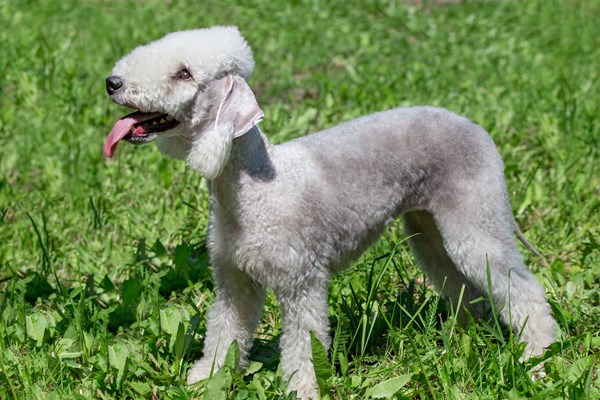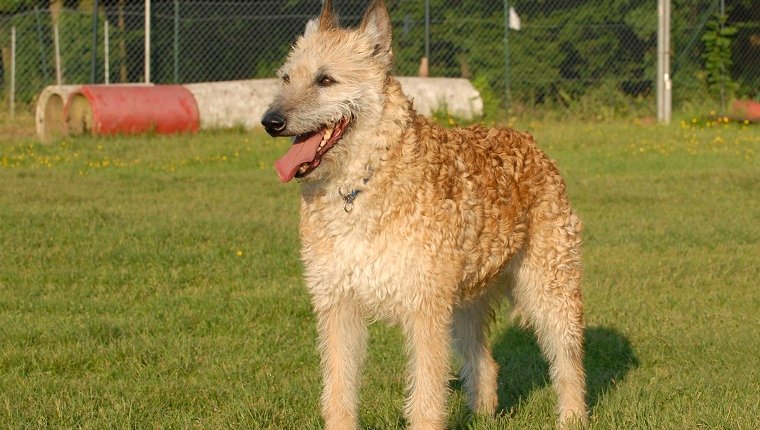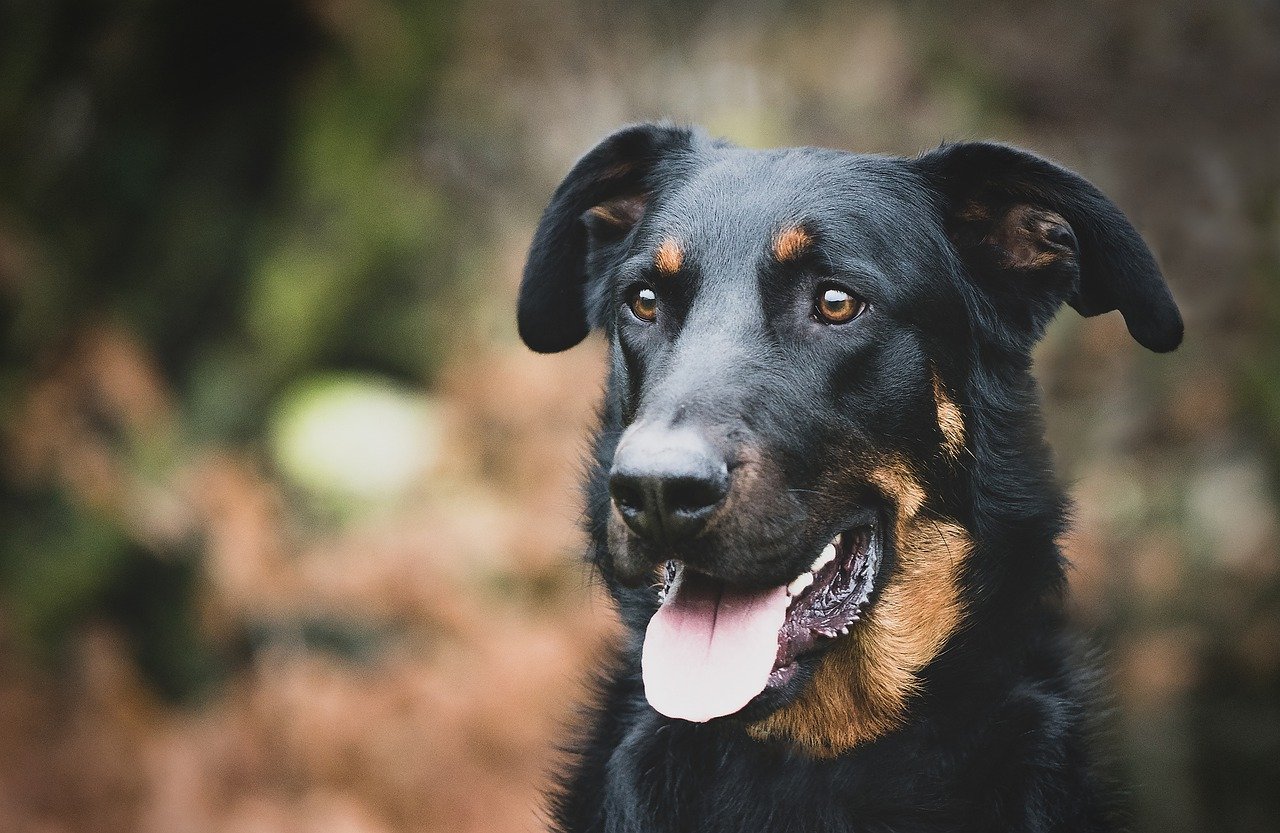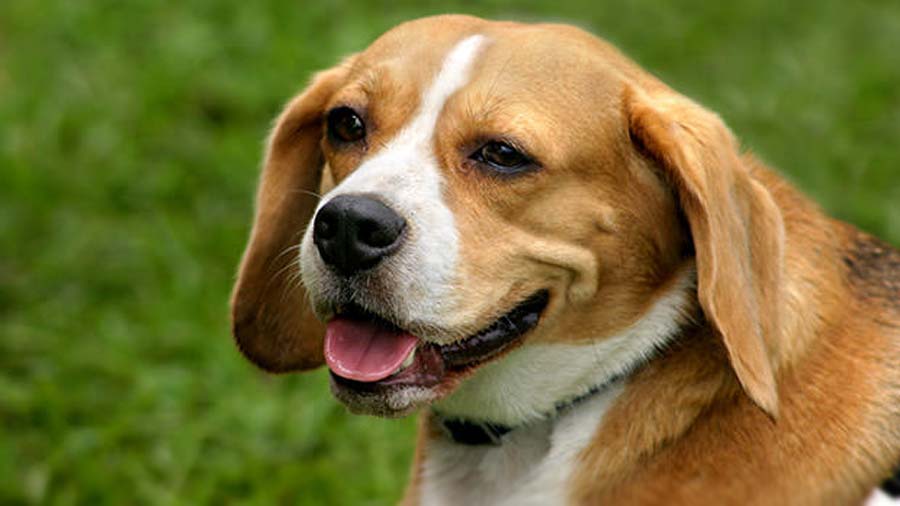Bedlington Terrier Dog Overview
This elegant, lithe dog has a distinct form. The arching loin and racy form of this breed allow for outstanding speed and agility.
The Bedlington, a wolf in sheep’s clothing, is unsurpassed in its ability to pursue and engage agile but tenacious quarry.
The stride is quick and springy. The coat is a blend of hard and soft hair that stands off the skin, providing strong protection as well as an excellent appearance.
Bedlington Terrier Highlights
- Bedlingtons can be obstinate at times.
- To avoid difficulties, early socialization with other pets is essential.
- Bedlington Terriers require exercise and mental stimulation or they may become bored and cause problems.
- When challenged by another dog, males can be vicious warriors.
- Bedlingtons are extremely intelligent and relatively simple to teach. They are unresponsive to severe training approaches.
- Bedlingtons require grooming once or twice a week to keep their coats in good condition and to prevent matting.
- Bedlingtons are single-person dogs.
- Bedlingtons are terriers who enjoy digging.
- A gated yard is required for Bedlingtons. They will chase after other animals and are extremely swift.
Bedlington Terrier Breed Features & Ratings:
Rated base on a 5 Star Scale
ENERGY LEVEL: 3 Star
EXERCISE REQUIREMENTS: 3 Star
PLAYFULNESS: 3 Star
AFFECTION LEVEL: 3 Star
FRIENDLINESS TO DOGS: 3 Star
FRIENDLINESS TO OTHER PETS: 2 Star
FRIENDLINESS TO STRANGERS: 4 Star
WATCHFULNESS: 1 Star
EASE OF TRAINING: 2 Star
GROOMING REQUIREMENTS: 5 Star
HEAT SENSITIVITY: 3 Star
VOCALITY 5 Star
Bedlington Terrier Characteristics:
- Dog Breed Group: Terrier Dogs
- Height: At the shoulder, it should be 15 to 16 inches tall.
- Weight: 17 to 23 pounds
- Life Span: 14 to 16 years
- Type: Purebred
- AREA OF ORIGIN: England
- DATE OF ORIGIN: 1800s
- OTHER NAMES: Rothbury Terrier, Rodbery Terrier
- Temperament: Affectionate, Devoted, Energetic, Loyal, Playful, Reliable, Intelligent
- Activities: Agility, Obedience, Rally Obedience, Conformation
- Color: Blue, sandy, liver, blue-and-tan, sandy-and-tan, or liver-and-tan
- Litter Size: 3-6 puppies
- Puppy Prices: $1800 – $2500 USD on average
Bedlington Terrier Health:
The Bedlington is a generally healthy breed, and responsible breeders will screen their breeding stock for health disorders such as hip and elbow dysplasia, hypothyroidism, von Willebrand’s disease (a blood ailment), thrombopathia, and some eye problems.
Bedlingtons’ ears, like all breeds, should be checked on a regular basis, and their teeth should be washed everyday.
The National Breed Club recommends the following health tests:
- Copper Toxicosis DNA Test
- Cardiac Exam
- Patella Evaluation
- Ophthalmologist Evaluation
Bedlington Terrier Grooming:
The Bedlington’s coat is a rare mixture of rough and soft hair. It has a sharp but not wiry feel to it with a curling propensity, especially on the head and face. It doesn’t shed much light.
The breed’s coat should be no longer than one inch length on the torso, with the hair on the legs slightly longer.
We usually think of him as white, but the Bedlington is available in a variety of hues and combinations, including blue, sandy, liver, blue and tan, sandy and tan, and liver and tan.
Tan markings can be present on the legs, chest, beneath the tail, inside the hindquarters, and over each eye in bi-colors. Bedlington puppies are born black and lighten as they age.
All adults’ topknots (a tuft of longer hair on top of the head) should be lighter than their skin tone.
Unlike many other terrier breeds, the Bedlington’s coat does not require stripping. You should comb him at least once a week.
You can take him to a ethical groomer for a lamb clip, or your Bedlington breeder can give you knowledge on how to do it yourself. To achieve the distinct appearance, the face must be hand-scissored.
Dental hygiene and nail care are two more grooming requirements. Brush your Bedlington’s teeth at least twice a week to remove tartar and the bacteria that live within it.
Brushing twice a day is even preferable if you want to avoid gum disease and foul breath. Nail trims should be done once or twice a month, or as needed.
They’re too lengthy if you can hear them clicking on the floor. Short, well trimmed nails maintain your feet in good shape and keep your shins from getting scratched when your Bedlington jumps up to welcome you.
When your Bedlington is a puppy, start accustoming him to being brushed and examined. Handle his paws frequently – dogs’ feet are sensitive — and inspect his lips and ears.
Make grooming a pleasurable process full of praise and prizes, and you’ll build the framework for smooth veterinarian tests and other handling when he’s an adult.
Bedlington Terrier Exercise:
Bedlingtons, like most Terriers, have a lot of energy and need to be exercised on a regular basis to be fit and happy. The breed is active yet not boisterous or mischievous.
A Bedlington enjoys playing fetch or going for a long walk or run, but after that, he’s content to curl up on the couch with his family.
Bedlingtons, despite their lamb-like appearance, were developed to chase small animals, and that is exactly what they do.
As a result, they require a fenced-in yard and must be walked on a leash at all times. Many Bedlingtons compete in agility, obedience, tracking, and earthdog events.
Bedlington Terrier Training:
Because they are terriers, the Bedlington has a lot of energy and will need frequent exercise for both their physical and mental well-being—this breed will love to play fetch or go on a long walk or run, but they are just as content to curl up on the sofa with their family afterward.
They do bark a lot and can become high-strung if not given enough exercise and mental stimulation. While this breed is lively, it is not rowdy or naughty.
The Bedlington Terrier, like most terriers, may be stubborn yet also bright and eager to please, thus early training and socialization is suggested.
This breed will not respond to severe training methods or physical correction because it will result in a power struggle with their owner.
Instead, owners who are not passive and are willing to remain firm and constant while relying on positive-reinforcement approaches, such as delivering praise and food as rewards, should perform training.
Despite their resemblance to lambs, Bedlingtons were developed to pursue small animals. As a result, this breed will need a fenced-in yard and should always be walked on a leash because they are prone to running away in chase of another animal.
It is also advisable to introduce these dogs to other family pets like cats while they are puppies. Many of these dogs enjoy sports and competitions including agility, tracking, and obedience.
Bedlington Terrier Food and Nutrition:
The Bedlington Terrier should thrive on high-quality dog food, which can be purchased commercially or cooked at home (with veterinary supervision).
They, like many dogs, can become overweight, so calorie intake and weight should be closely managed by a veterinarian at all times. This active dog must also have constant access to clean, fresh water.
Bedlington Terrier Temperament and Personality:
The Bedlington is a good companion and watchdog since it is alert, lively, and intelligent. He enjoys being the center of attention and entertaining his audience.
He can be aggressive to other dogs of his sex and will chase small furry animals.
A variety of factors impacted temperament, including heredity, training, and socialization. Puppies with good temperaments are interested and playful, eager to approach and be held by people.
Choose the puppy in the midst of the pack, not the one who is tearing up his littermates or hiding in the corner. Meeting the parents’ siblings or other relatives is also beneficial in determining what a puppy will be like when he grows up.
Bedlingtons, like all dogs, require early socialization — being exposed to a variety of people, sights, noises, and experiences — when they are young. Socialization ensures that your Bedlington puppy develops into a well-rounded dog.
Enrolling him in puppy kindergarten is a terrific place to start. Inviting guests over on a regular basis, as well as taking him to busy parks, stores that accept dogs, and on leisurely strolls to meet neighbors, will help him improve his social abilities.
Bedlington Terrier Care/Upkeep:
Bedlington Terriers are a sturdy breed with a moderate amount of energy. They can run at tremendous speeds, thus a securely secured space is essential.
These dogs are not adapted to life in the open air. They are small enough to fit in an apartment if they have a safe space to exercise.
A good walk or a lively game of fetch might be considered exercise for the Bedlington. He can accompany you on a jog or a hike.
You can also teach him agility, obedience, and tracking skills. He’s calm at home, content to sit on the sofa with you. Bedlington is intelligent, and his intellect makes him difficult to train.
He performs best when you can persuade him that what you want is actually his idea or helps him in some manner.
Positive reinforcement tactics such as praise, play, and food rewards should be used. Harsh words and physical force will simply bring out his obstinate streak and start a fight of wills that you will almost certainly lose.
Bedlington Terrier Relationship with Children and Other Pets
When raised with youngsters, the Bedlington can be a rambunctious playmate. He’s most likely best suited to homes with older children.
While a Bedlington will endure some rough handling, he will establish limits when things become too rough, and he doesn’t realize that a child’s skin isn’t as tough as another dog’s.
Constantly teach youngsters how to handle and hold dogs, and always monitor any encounters between dogs and small children to avoid biting or ear or tail pulling on either party’s side.
Teach your child never to approach a sleeping or eating dog or to try to grab the dog’s food. No canine should ever be left alone with a youngster.
Bedlingtons get along with other canines, especially if they’ve been raised with them, but they can be violent with dogs of the same gender. And, like most terriers, they will not initiate a fight, but they will not back down from one either.
When aroused, Bedlingtons may be vicious fighters, so be cautious when presenting them to unfamiliar canine companions, particularly other adults of the same sex. Male Bedlingtons, in particular, will fight until serious harm is done.
If nurtured with your indoor cat, a Bedlington may learn to get along with him, but outdoor cats as well as other animals will be fair game for him to chase.
Bedlington Terrier Names
| Rank | Boy Names | Girl Names |
| 01 | Max | Bella |
| 02 | Cooper | Lucy |
| 03 | Toby | Molly |
| 04 | Jake | Annie |
| 05 | Tucker | Lulu |
| 06 | Bruno | Roxy |
| 07 | Oliver | Lola |
| 08 | Zeus | Ellie |
| 09 | Lucky | Lexi |
| 10 | Bailey | Sophie |
All About Bedlington Terrier
The Bedlington Terrier draws you in with his unusual lamblike appearance and keeps you there with his amusing, opinionated demeanor. But don’t be fooled by his outward appearance.
The Bedlington is a terrier at heart: curious, intelligent, vigilant, and aggressive against small animals when out in the open. The Bedlingtons immerse themselves in their family’s activities with zeal.
They crave being the center of attention of the owners and will play the clown to achieve it. Bedlingtons love visitors and entertain them with their antics, but they’ll let you know if they suspect someone of being suspicious.
People in Bedlington claim their dogs have good judgment and make wonderful watchdogs. Exercise is essential for a Bedlington’s happiness and health, yet he has moderate energy levels and activity requirements.
Despite the fact that he is rarely utilized in the field, his hunting abilities encompass pointing, retrieving, tracking, alongside going to ground after den creatures. Whatever you do to him, he’ll be content to remain a couch potato afterwards.
When raised with youngsters, the Bedlington can be a rambunctious playmate. When dealing with any dog, make sure that really young children are monitored by an adult to avoid injury to both.
While a Bedlington will endure some rough handling, he will establish limits when things become too rough, and he doesn’t realize that a child’s skin isn’t as tough as another dog’s.
Bedlingtons get along well with other dogs, particularly if they are raised with them. They may not initiate a conflict, but they will not back down from one.
Although the Bedlington appears fluffy and loving, he is no pushover and will not willingly accept another dog’s attempt to control him.
The Bedlington, with correct training and socialization, makes a superb companion and enthusiastic partner in all family activities. You’ll enjoy his sense of humour and eagerness to make the most of life.
Bedlington Terrier History:
The Bedlington Terrier is a one-of-a-kind, lamb-like breed that is thought to have been bred from sighthounds like the Whippet due to its arched back (not to mention its speed and agility), but it is also thought to share common ancestry with breeds like the Dandie Dinmont, Kerry Blue, and Soft-Coated Wheaten Terriers.
They move with a smooth, springy step but can run quite swiftly when necessary.
Though they appear to be peaceful lambs, the Bedlington has been responsible for extremely difficult—and often deadly—work throughout their history.
These bold, energetic canines were bred in the 1800s in the Northumberland mining shire of Bedlington as a working man’s dog.
The Bedlington was a prized hunting dog of animals like foxes, hares, and badgers, and the miners of Bedlington expected them to be vermin hunters.
Piper, the first Bedlington Terrier, was a dog. Piper, who was born in 1825, is claimed to have been hunting badgers at the age of 14 despite being practically blind and lacking teeth.
At the time, the Bedlington was thought to be the brightest and fastest terrier breed.
In fact, the breed was given the nickname “Gypsy Dog” because it was frequently used as a sly accomplice in poaching by roving Romanies.
Lord Rothbury of Bedlington identified the “Gypsy Dog,” and he became such a fan of the breed that the terriers were often referred to as Rothbury’s Terrier—and, in some instances, Rothbury’s Lamb.
Bedlington’s nail makers were also fans of the breed, and it wasn’t long before the shire’s miners and nailers began betting their wages on dogfights in which they pitted their terriers against one other.
They discovered that, despite its lamb-like look, the Bedlington Terrier would develop into vicious fighters who would not back down when challenged and, regrettably, they would battle to the death if forced to do so. While miners used Bedlingtons as fighting dogs, hunters relied on them as retrievers.
The good news is that the Bedlingtons were discovered to be more of a lover than a combatant.
These adorable dogs eventually ascended from coal mines and nail factories to be welcomed into manor houses, where British aristocrats raised their Bedlingtons to be both lovable pets and attractive decorations as part of their rich, fashionable lifestyles.
The National Bedlington Terrier Club of England was founded in 1877, while the American Kennel Club (AKC) registered its first Bedlington less than ten years later.
Bedlington, England, is still proud of its famous export; the Terriers are the name of the town’s Northern League soccer team, and the community even constructed park benches designed after the breed.
Where to Adopt Bedlington Terrier:
Check your local animal shelters and rescue organizations for Bedlington Terriers in need of a forever home.
The Bedlington Terrier Club of America, a national rescue organization for Bedlington Terriers, can also give internet tools to assist you find your new best buddy.
More Dog Breeds and Further Research:
When selecting a dog breed, make sure to conduct your research. Speak with other Bedlington Terrier owners, trustworthy breeders, and rescue organizations to learn more about this breed and its care.
There are several dog breeds to choose from, and with a little research, you can be confident that you’ll select the perfect dog to bring home.
Consider the following comparable dog breeds if you want to learn more about them:
Bedlington Terrier Fun Facts:
- Bedlington Terriers usually grow less than 17 inches tall.
- Bedlington Terriers are tenacious hunters.
- Bedlington Terriers have a two-sided temperament.
- Bedlington Terriers do not always get along with other dogs.
- Bedlington Terriers need long daily walks.
Frequently Asked Questions (FAQs):
The Bedlington Terrier dog breed began as a vermin exterminator and hunter’s sidekick. Bedlingtons are becoming popular as companions and in the show ring. They still have good hunting instincts, a keen sense of smell, and a strong desire to go to ground, but they are rarely utilized in the field.
Bedlingtons were bred to rid the countryside of aggressive vermin like badgers, weasels, polecats, rats, and martens. The “fall” on the dog’s head served to protect the dog’s eyes and ears from its prey’s sharp teeth. It’s thought that the ear tassels served as decoys because grabbing one resulted in a mouthful of fluff.
They can run up to 3 miles.




